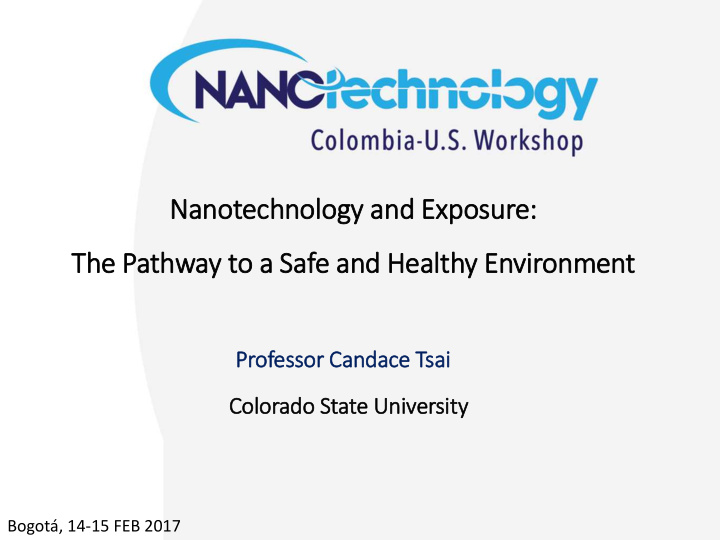



Nanotechnology and Exposure: The Pathway to a Safe and Healthy Environment Professor Candace Tsai Colorado State Univ iversity Bogotá, 14-15 FEB 2017
Nanotechnology and Nanomaterials
Engineered Nanoparticles- Intentional Materials Carbon nanotube Titanium dioxide Carbon black 20 nm
4 Lee et al. ACS Nano 4(7) 2010
Ref: Canada NanoPortal • Nanomaterials is released and distributed into water and air Ref: Lowry, et al., ES&T, 2012, 46(13), 6893 • Environmental transformations of nanomaterials cause complicated exposure and effect 5
Nanomaterials use in wastewater treatment • Iron oxide nanomaterials • Carbon nanotubes (CNT) Nanomaterials use for water purification Use carbon nanotubes to remove Ref: Nasa website microorganisms from large quantities of water quickly, provide drinking water for astronauts. 6
CNT Properties and Application flexible carbon nanotube battery • High electrical conductivity • High thermal conductivity • Very high tensile strength Nanotube Textile • Highly flexible CNTs expand epoxy • High surface to volume ratio! ….. and more applications 7
Nanoparticles at beach Nanoparticles (Titanium dioxides, TiO 2 ) used in sunscreens and other consumer products may harm marine creatures by disabling the defense mechanisms that protect their embryos. Ref: National Geographic, May 2015 8
Nanoparticles for newborn? Needle-like particles of hydroxyapatite found in infant formula by researchers. 9 Westerhoff and Schoepf/ASU, CC BY-ND
Effect to fetus? • Drug delivery • Inhalation, injection or ingestion 10
Exposure at Workplaces 11
Inhalation Exposure Pleura 13
From Respiratory Tract to Brain
Human Exposure Case A chemist formulated polymers and coatings usually using silver ink particles. When she later began working with “ nickel nanoparticle powder” weighed out and handled on a lab bench with no protective measures, she developed throat irritation, nasal congestion, post nasal drip, facial flushing , and….. This incident triggered the company to make plans for “ better control measures” for working with nickel nanoparticles. Ref: 2014, American J of Industrial Medicine, Journeay and Goldman 16
Some nanoparticles are potential carcinogens 17
International Agency for Research on Cancer (IARC) classified Multiwalled Carbon Nanotubes (MWCNT) type 7 and TiO 2 as 2B carcinogens in 2014. 18
CNT in children’s lung in Paris Ref: Kolosnjaj-Tabi, EBioMedicin, 2015 19
20
Exposure Assessment 21
Invisible Airborne Particles 100 nm Nanoalumina Nanoalumina particle 45 nm 22 22 22
23
24
25 25 25
Sampling Technique TEM grid (diameter 3.05 mm), Polycarbonate filter, 0.2µm Air stream pore (diameter 25 mm) Bottom support Cassette base Pump Tsai diffusion sampler (TDS) o Operated at low flowrate of 0.3L/min. o Collected nanoparticles on grid by Brownian motion. o Analyze particles using SEM on filter and TEM on grid. 26
Exposure Control and Protection 27
28 Laboratory fume hood o Airflow pattern is the major issue to cause exposure. o Nanoparticles behave like a gas. o Proper controls are necessary and important. Publication: Tsai et al. JNR 2009; Tsai et al. Annals of Occu H, 2010; Tsai, JNR 2013.
o Exposure from manufacturing and cutting nanocomposites o Controls to reduce exposure o Material property test 29
Near-fie ield ld, source nd port ld, 2 nd Far-fie ield rt Air velocity at 2 nd port, 0.74m away from the enclosure open slot, was reduced to 67 ft/min from 2400 ft/min. Silverman equation Q V ( x ) 3 . 7 Lx Tsai et al., AAQR, 2008. Tsai et al., NANO, 2008. Ashter et al., Polymer Eng. Sci. J.,2009. 30 Tsai et al., JNR , 2012
Isolation Ventilation Filtration Hopper & Enclosure 2 nd port o Exposure studied at near field and far field o Isolation significantly reduced particle escape o Enclosure and modified airflow/air velocity controlled exposure o Emission during processing at 2 nd port contain individual particle
Protective Clothing? 32
(c) (d) Polyester (c, d) and Tyvek (e, f) fabric contaminated with nanoalumina particles Polyester fabric Improve property of fabric fiber to (e) (f) peel off nanoparticle Tyvek fabric Tsai, S., Contamination and Release of Nanomaterials Associated with the Use of Personal 33 Protective Clothing, Annals of Occupational Hygiene, 2015, 1-13
Regulations and Actions 34
Toxic Substance Control Act (TSCA) reporting Final rule for Chemical Substances When Manufactured or Processed Ref: US EPA 2017 as Nanoscale Materials 35
• US National Institute for Occupational Safety and Health (NIOSH) Recommended Exposure Limits (REL) • Carbon nanotubes 1 μ g/m 3 (2013) • As measured by NIOSH 5040 (elemental carbon) Based on Limit of Quantification (LOQ) • UK British Standard Institute (BSI) Occupational Exposure Limit (OEL), Swiss Accident Insurance Funds, German Institute for Occupational Safety and Health • Carbon nanotube 0.01 fibers/cm3 • As measured by scanning or transmission electron microscopy SEM/TEM • Japan OEL • 30 g/m 3 for SWCNT, 80 g/m 3 MWCNT • Based on no observed effect levels (NOELs)
Active non-profit organizations • American Industrial Hygiene Association (AIHA), Nanotechnology Working Group • Sustainable Nanotechnology Organization (SNO) • GoodNanoGuide, https://nanohub.org/groups/gng 37
Question? Dr. Candace Tsai, Candace.Tsai@colostate.edu
Recommend
More recommend